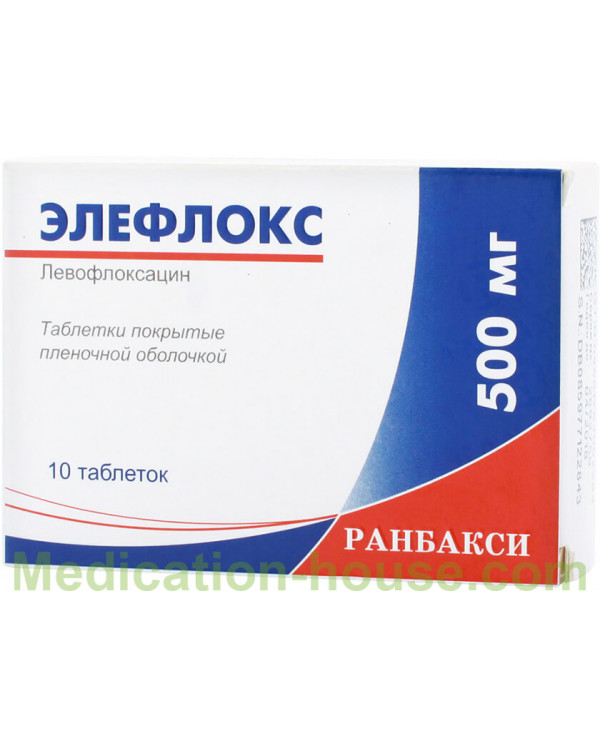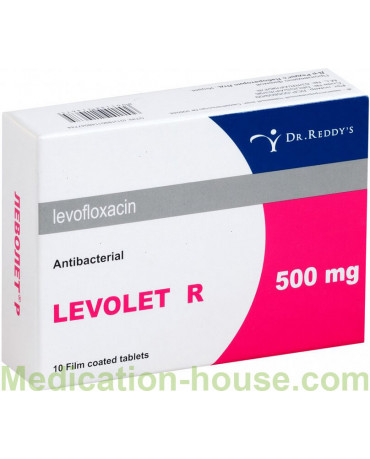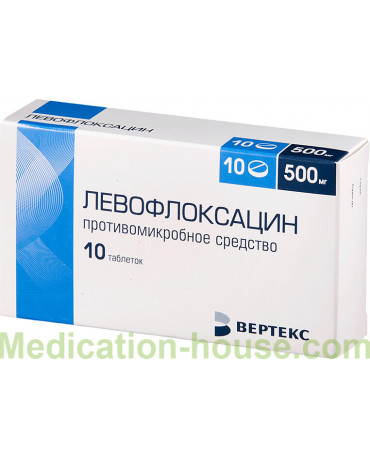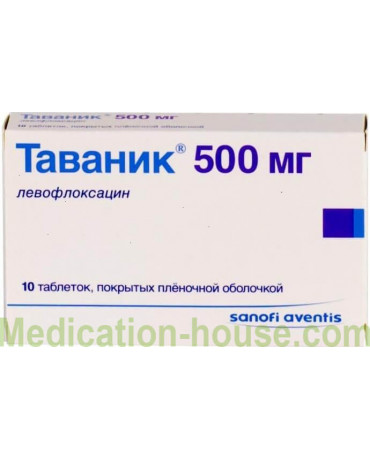Instruction for Eleflox
You can buy Eleflox here
Composition and dosage forms
The main active ingredient is levofloxacin hemihydrate. This is a synthetic antibiotic with a wide spectrum of action. Eleflox is available in tablets and in the form of a solution for infusion.
Pills
Yellowish-pink oval biconvex tablets on one side have an engraving that indicates dosage. A unit of the formulation may contain 250 or 500 mg of levofloxacin. Tablets are placed in blisters and cardboard packs.
Solution
Dosage form intended for infusion, is a yellowish-greenish, almost transparent solution. It comes in a glass vial packed in a carton box. 1 ml of Eleflox contains 5 mg of the active ingredient. The volume of the bottle is 100 ml.
Pharmacological group
Eleflox is a synthetic antibiotic. Included in the group of fluoroquinolones. It has a wide spectrum of action.
pharmachologic effect
The main substance, penetrating into the focus of inflammation, stops the synthesis of DNA gyrase. Without this special protein, the vital activity of pathogenic microorganisms is disturbed, the cytoplasm and membranes are destroyed, and cell death occurs. The active ingredient has an antibacterial effect not only of pathogens that are in the stage of growth and reproduction, but also on those who are at rest.
Eleflox is effective against a large number of gram-positive and gram-negative aerobic infectious agents, such as:
Bacillus anthracis;
Corynebacterium diphtheriae, Corynebacterium jeikeium;
Enterococcus spp .;
Listeria monocytogenes;
Staphylococcus spp .;
Streptococcus, including Streptococcus agalactiae, Streptococcus pneumoniae;
Acinetobacter and Enterobacter;
Gardnerella vaginalis;
Haemophilus ducreyi, Haemophilus influenzae;
Helicobacter pylori;
Klebsiella, Moraxella, Neisseria meningitidis;
Pasteurella spp .;
Proteus mirabilis, Proteus vulgaris;
Salmonella spp.
Some anaerobic microorganisms are sensitive to Eleflox. These include Bacteroides fragilis, Bifidobacterium spp., Clostridium perfringens, Fusobacterium spp., Peptostreptococcus, Propionibacterum spp. In addition, the drug is effective against intracellular and other infectious agents, for example, some strains of chlamydia, mycobacteria and ureaplasma.
The active components of Eleflox are rapidly absorbed into the blood. Up to 40% of compounds are bound to plasma proteins. The maximum concentration of levofloxacin is reached in 30-60 minutes after administration. Bioavailability is 98-100%.
The antibiotic penetrates into the tissues of internal organs and biological fluids, is found in therapeutic concentrations in the bones and joints. Levofloxacin is eliminated from the body through the kidneys almost unchanged. The half-life is 6-8 hours. When ingested and administered infusion, the bioavailability and efficacy of the drug is almost the same. Therefore, dosage forms are interchangeable.
What is Eleflox prescribed for?
Combined therapy with the use of Eleflox is carried out in case of diseases caused by the growth of pathogenic microflora sensitive to the drug. Indications for use of Eleflox:
pathologies of the upper and lower respiratory tract and ENT organs, including sinusitis, sinusitis, sinusitis, exacerbation of chronic bronchitis;
community-acquired pneumonia;
urinary tract and kidney infections (cystitis, urethritis, pyelonephritis, chronic bacterial prostatitis in men);
inflammatory bone diseases;
defeat of the skin and soft tissues;
complex treatment of some forms of tuberculosis resistant to standard drugs;
prevention and treatment of airborne anthrax.
The use of tablets or solution for infusion is possible only after consulting with your doctor and determining the sensitivity of the pathogen to the active substance.
How to take Eleflox
Tablets are swallowed whole with water. It is recommended to take Eleflox before meals or between meals. The solution for infusion is administered intravenously through an IV drip. Infusion should last from 30 minutes to 1 hour, depending on the amount of antibiotic prescribed.
The dosage of Eleflox is determined by the doctor, taking into account the severity of the disease, the patient's age and associated pathologies. For acute sinusitis, 500 mg should be taken 1 time per day. Therapy lasts from 10 days to 2 weeks. With exacerbation of chronic bronchitis use the same scheme for 7-10 days. Treatment of community-acquired pneumonia takes 14 days. The daily dose of the drug is 500-1000 mg.
To combat infectious and inflammatory diseases of the urinary system, take 250 mg 1 time in 24 hours for 3 days. In severe cases, the daily dose is increased by 2 times, the therapeutic course lasts up to 2 weeks. In chronic bacterial prostatitis, the duration of treatment is up to 28 days at a dosage of 0.5 g once a day.
If a patient has an infectious pathology of the skin and soft tissues, then most often it is prescribed 500 mg of levofloxacin 1-2 times a day for 1-2 weeks. For severe forms of tuberculosis: 500-1000 mg of Eleflox per day take up to 3 months. As a prophylaxis, as well as for the treatment of anthrax during airborne infection, the administration of Eleflox is recommended for 0.5 g to 2 months.
special instructions
In rare cases, the active components of an antibacterial agent cause a prolongation of the QT interval, and women and the elderly are especially sensitive to this. The latter may also occur kidney damage or the development of Achilles tendonitis. In this case, you should stop taking the medication and start the appropriate therapy.
Chronic liver disease does not require adjustment of the dosing regimen, since almost the entire volume of Eleflox is excreted through the urinary system. With low creatinine clearance, the doctor reduces the number of pills or increases the intervals between use of the antibiotic.
Fluoroquinolone recipients are not recommended to be exposed to ultraviolet radiation. In people with impaired cerebral circulation who have had a stroke, the development of seizures seizures is not excluded.
Eleflox is used with caution in patients with mental illness. In some cases, the resistance of infectious agents varies by region. Therefore, the identification of sensitive microorganisms with the help of laboratory studies is necessary.
Taking fluoroquinolones adversely affects concentration and slows down psychomotor reactions, so people associated with the management of complex equipment, drivers and employees of high-risk industries need to be careful during the course of antibiotic therapy.
During pregnancy and breastfeeding
During pregnancy, the drug Eleflox is prohibited, since the active substances penetrate the placental barrier and can provoke fetal malformations. When breastfeeding for the entire period of treatment, the child is transferred to artificial nutrition.
Side Effects of Eleflox
Levofloxacin in some cases causes various side effects:
On the part of the digestive tract is often observed indigestion, nausea and vomiting. Perhaps the appearance of pain in the abdomen after oral administration. Pseudomembranous enterocolitis is not excluded.
Impaired liver function leads to increased activity of hepatic transaminases and other enzymes. In severe cases, cholestatic hepatitis and jaundice develop. Rarely occurs necrosis of the liver.
Admission Eleflox can provoke prolongation of the QT interval, the development of ventricular tachycardia and cardiac arrest. Some patients have sharp jumps in blood pressure.
On the part of the urinary system, renal dysfunction occurs. Interstitial nephritis possible.
During treatment often changes in blood parameters. Leukopenia, agranulocytosis, hemolytic anemia, thrombocytopenia, neutropenia and eosinophilia are observed.
Eleflox affects the work of the senses. Some patients note a decrease in visual acuity and hearing, impaired sense of smell, a change in taste.
From the side of the central nervous system may appear dizziness, migraine, tremor, confusion, paresthesia, impaired coordination of movements. In some cases, mental disorders occur: from nightmares, depression and phobias, to suicidal thoughts.
During therapy there is a risk of tendon rupture. The development of arthralgia, myasthenia, myalgia is not excluded.
Fluoroquinodones cause various allergic reactions. Cases of urticaria, pruritus, bronchospasm, angioedema and anaphylactic shock have been reported.
An antibiotic can provoke the occurrence of superinfection, dysbacteriosis, candidiasis.
The appearance of negative reactions during the treatment period requires immediate cessation of medication and consultation with a doctor.
Contraindications for Eleflox
The drug is contraindicated in pregnancy, while breastfeeding and for children under 18 years. The use of Eleflox is prohibited for the treatment of people with deficiency of glucose-6-phosphate dehydrogenase. An antibiotic is not recommended for people with a history of severe pathologies associated with circulatory disorders, stroke or traumatic brain injury.
Chronic and acute renal failure with low creatinine clearance is a contraindication. The drug should not be taken with myasthenia gravis, severe mental disorders, individual intolerance to the components that make up Eleflox. Antibiotic is prohibited for patients with convulsive syndrome, including in epilepsy. With caution should take pills for diabetes.
Overdose
Exceeding the recommended amount of the drug leads to negative body reactions: nausea, vomiting, shortness of breath. In severe cases, may have difficulty breathing, convulsions, cardiac arrest. With an overdose, disorders of the central nervous system are observed: confusion, impaired motor coordination and an objective assessment of reality.
Specific antidote not found. Hemodialysis in this case does not bring a positive result. Symptomatic therapy is used to relieve acute symptoms.
Interoperability and compatibility
Reception of Eleflox in conjunction with non-steroidal anti-inflammatory drugs is not recommended due to the risk of convulsive syndrome. Glucocorticosteroids with simultaneous use provoke tendon rupture. Loop diuretics and other drugs that block tubular secretion, increase the concentration of the antibiotic, slow down its excretion and enhance the nephrotoxic effect.
Indirect anticoagulants increase the risk of bleeding. Patients who are constantly taking medication against arrhythmias and tricyclic antidepressants should use Eleflox with caution.
Antacids and medicines containing aluminum, magnesium, potassium and iron salts reduce the effectiveness of the antibiotic. Between receptions of these means the two-hour interval is necessary. The combination of Eleflox with hypoglycemic drugs can provoke a sharp decrease in blood sugar levels.
With alcohol
Ethanol in combination with levofloxacin causes severe side effects and reduces the antibacterial activity of Eleflox. Taking alcohol during therapy is not allowed.
Terms and conditions of storage
Tablets and infusion solution should be stored in a dark and dry place with the maintenance of room temperature. It is recommended to limit the access of children to the pharmaceutical product. The shelf life of the antibiotic in pill form is 3 years. Solution for infusions is stored no more than 2 years.
Reviews
Valeria, 37 years old, Zelenogorsk
Classic: chill legs, began to often run to the toilet. At first, the doctor decided to do with “little blood”, prescribed Fitolysin, said it was a herbal combination drug, without harm, etc. The main mistake that did not immediately insist on antibiotics. It only got worse. Connect the "heavy artillery" in the form of Eleflox. Helped quickly. In addition to dysbiosis there are no side effects. But it is expensive. This is the only negative.
Terms of sell
You don't need a prescription to buy Eleflox.




